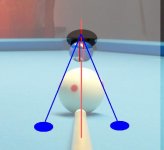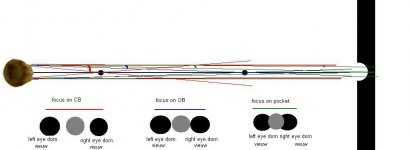i recommend this read to every player.
http://findarticles.com/p/articles/mi_m0HFI/is_2004_Jan/ai_112104116/pg_1?tag=artBody;col1
Since sienctific studies on eye gaze and quiet eye, there have been more and more implementations of the technique into sport. This article talks about golf, but it is exactly the same for pool.
I can't find the url anymore, but i read they used gaze folowing machienes, and compared the gaze of 24 poolplayers: 12 good and 12 ballbangers, and the better poolplayers all had a more quiet eye.
i'm going to use the quiet eye training for a month and see if i can see any progression.
**********************
xtra
I'm still trying to find an explenation on visual illusions on certain shots. (ex long shots on a ob against the rail at 1 diamond from the corner, and cb 1 or 2 diamonds wide from the siderail on the headstring.)
i don't remember in wich pool instructional poolvideo i saw it (if anyone knows what i'm talking about, plz post the link. i know i read it here on AZB, but they told you to just shoot it straight, even if the eyes saw an angle, and it would go in... but i havent been able to find any scientific explenation for wich shots this happens and why. I had done some thinking before, and the first clue had to do with 2 parallel lines will come closer and form an angle the further you look. || will be more lile /\, so if this is true for paralel lines, it also aplies when you use the rail and the line from the OB to the pocket as a way to measure the angle. You might see a 30? angle and play half ball, where in real life it is only 20? + 10? due to the distance, and the half ball hit will make you miss the shot.
I know if i can understand why sometimes my eye give me the wrong angle, i could become a better potter. I personally use the ghostball and contact point to define my aiming line and it helps on 95% of the pots, but seeing the angle and judging it right is a 3th part of the information that helps me aim better.
imagine the 8ball 6 foot away. How can you focus on the contact point? its to farr to really focus (unless you have PERFECT vision) and the fully black surface makes it almost impossible to keep your gaze quiet for 3 seconds on a 1mm surface at that distance. this is just an example
If this 3th information can be wrong due to optical illusion, i'm sure that for 5% of the shots, they could make me double guess my aim, and make conscious or even subconsious adjustments that makes me miss the pot.
I've been trying to counter this, by judging the angle when standing up, and if i see a 30? angle, i WILL play it half ball, no matter of when down it looks like 35 or 40?. Perfect example is speed pool. When i play speedpool, my stroke isn't 100% perfect, but my aiming line ALWAYS is 100% right, and i miss less do to a right aiming line but a 80% perfect stroke, then i do with a 80% aim and a 100% perfect stroke. And i'm sure that my eyes judje the aimingline and angles better, because i'm calculating them while running to the next ball. Now i would want a 100% aim/angle and 100% stroke, and for that i need to understand what optical illusions happen in pool. (colours of balls also have an influence, but i'm mainly focusing on angles now)
I know I aborted this subject once, and in short the reactions where that i was going tomuch in detail about how we see things and that my drawings made people deasy , and thinking about it would make them miss even more so noone really helped getting some conclusions and tests and opinions.
, and thinking about it would make them miss even more so noone really helped getting some conclusions and tests and opinions.
edit: i'll try to find my old post and hope the read on the quiet eye will encourage to have more EYE posts, then AIM posts. dont forget: your EYE'S , tell your brain to tell your muscles where to STROKE. If the eye's are wrong, the stroke might be perfect, but the ball wont go in.
The only thing people do talk about is dominant eye, but thats as far as it goes and i find it sad.
PS here was one of the first posts: http://forums.azbilliards.com/showthread.php?t=81054&page=3&highlight=eyes
for the record: i'm using dominant eye over the cue now, and forcing its dominance and its working perfect for straight in shots.
Solly.
http://findarticles.com/p/articles/mi_m0HFI/is_2004_Jan/ai_112104116/pg_1?tag=artBody;col1
Since sienctific studies on eye gaze and quiet eye, there have been more and more implementations of the technique into sport. This article talks about golf, but it is exactly the same for pool.
I can't find the url anymore, but i read they used gaze folowing machienes, and compared the gaze of 24 poolplayers: 12 good and 12 ballbangers, and the better poolplayers all had a more quiet eye.
i'm going to use the quiet eye training for a month and see if i can see any progression.
**********************
xtra
I'm still trying to find an explenation on visual illusions on certain shots. (ex long shots on a ob against the rail at 1 diamond from the corner, and cb 1 or 2 diamonds wide from the siderail on the headstring.)
i don't remember in wich pool instructional poolvideo i saw it (if anyone knows what i'm talking about, plz post the link. i know i read it here on AZB, but they told you to just shoot it straight, even if the eyes saw an angle, and it would go in... but i havent been able to find any scientific explenation for wich shots this happens and why. I had done some thinking before, and the first clue had to do with 2 parallel lines will come closer and form an angle the further you look. || will be more lile /\, so if this is true for paralel lines, it also aplies when you use the rail and the line from the OB to the pocket as a way to measure the angle. You might see a 30? angle and play half ball, where in real life it is only 20? + 10? due to the distance, and the half ball hit will make you miss the shot.
I know if i can understand why sometimes my eye give me the wrong angle, i could become a better potter. I personally use the ghostball and contact point to define my aiming line and it helps on 95% of the pots, but seeing the angle and judging it right is a 3th part of the information that helps me aim better.
imagine the 8ball 6 foot away. How can you focus on the contact point? its to farr to really focus (unless you have PERFECT vision) and the fully black surface makes it almost impossible to keep your gaze quiet for 3 seconds on a 1mm surface at that distance. this is just an example
If this 3th information can be wrong due to optical illusion, i'm sure that for 5% of the shots, they could make me double guess my aim, and make conscious or even subconsious adjustments that makes me miss the pot.
I've been trying to counter this, by judging the angle when standing up, and if i see a 30? angle, i WILL play it half ball, no matter of when down it looks like 35 or 40?. Perfect example is speed pool. When i play speedpool, my stroke isn't 100% perfect, but my aiming line ALWAYS is 100% right, and i miss less do to a right aiming line but a 80% perfect stroke, then i do with a 80% aim and a 100% perfect stroke. And i'm sure that my eyes judje the aimingline and angles better, because i'm calculating them while running to the next ball. Now i would want a 100% aim/angle and 100% stroke, and for that i need to understand what optical illusions happen in pool. (colours of balls also have an influence, but i'm mainly focusing on angles now)
I know I aborted this subject once, and in short the reactions where that i was going tomuch in detail about how we see things and that my drawings made people deasy
edit: i'll try to find my old post and hope the read on the quiet eye will encourage to have more EYE posts, then AIM posts. dont forget: your EYE'S , tell your brain to tell your muscles where to STROKE. If the eye's are wrong, the stroke might be perfect, but the ball wont go in.
The only thing people do talk about is dominant eye, but thats as far as it goes and i find it sad.
PS here was one of the first posts: http://forums.azbilliards.com/showthread.php?t=81054&page=3&highlight=eyes
for the record: i'm using dominant eye over the cue now, and forcing its dominance and its working perfect for straight in shots.
Solly.
Last edited:


